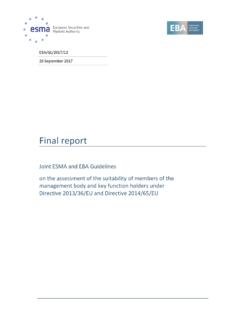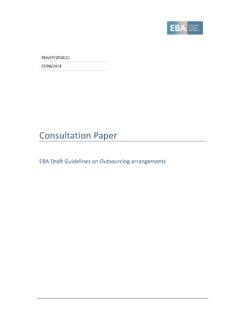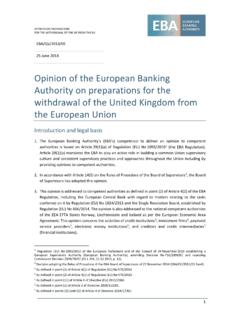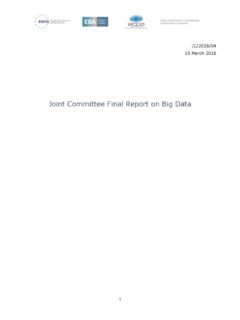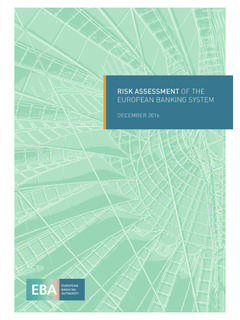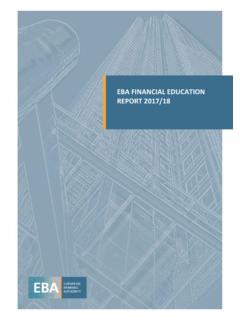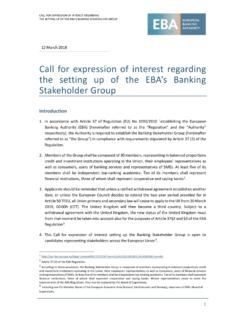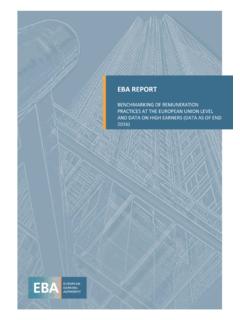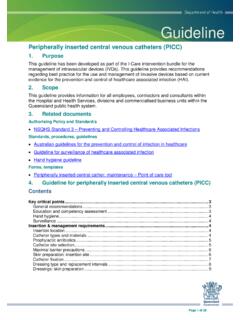Transcription of EBA BS 2019 XXX (Final draft Guidelines on ICT and ...
1 FINAL REPORT ON Guidelines ON ICT AND SECURITY RISK MANAGEMENT 1 EBA/GL/2019/04 28 November 2019 FINAL REPORT EBA Guidelines on ICT and security risk management FINAL REPORT ON Guidelines ON ICT AND SECURITY RISK MANAGEMENT 2 Contents 1. Executive summary 3 2. Background and rationale 6 3. Guidelines 8 4. Accompanying documents 30 draft cost-benefit analysis/impact assessment 30 Feedback on the public consultation 34 FINAL REPORT ON Guidelines ON ICT AND SECURITY RISK MANAGEMENT 3 1. Executive summary The complexity of information and communication technology (ICT) and security risks is increasing and the frequency of ICT and security-related incidents (including cyber incidents) is rising, together with their potential significant adverse impact on financial institutions operational functioning. Moreover, due to the interconnectedness of financial institutions, ICT and security-related incidents risk causing potential systemic impacts.
2 The EBA has responded to this by detailing how supervisors should cover ICT and security risks within supervision (EBA/GL/2017/05), by detailing how financial institutions should manage outsourcing (EBA/GL/2019/02) and by describing the expectations for ICT and security risk management for the financial institutions in these Guidelines . These Guidelines set out how financial institutions should manage the ICT and security risks that they are exposed to. In addition, this guidance aims to provide the financial institutions to which the Guidelines apply with a better understanding of supervisory expectations for the management of ICT and security risks. These Guidelines integrate and are built on the requirements set out in the Guidelines on security measures for operational and security risks of payment services (hereafter Guidelines on security measures ), which were published in December 2017 (EBA/GL/2017/17) and which have applied since January 2018 in fulfilment of the mandate in Article 95(3) of Directive 2015/2366/EU (PSD2).
3 Those Guidelines were addressed to payment service providers (PSPs), and only applied to their payment services; however, they were in fact relevant to a broader set of institutions. For that reason, these Guidelines have been formulated to be addressed to a broader range of financial institutions under the EBA s remit (namely to credit institutions which already fell within the scope of the Guidelines on security measures for their payment services, but for which these Guidelines will now apply for all activities) and to investment firms. These Guidelines continue to apply to PSPs for the payment services they provide; they extend to other activities of credit institutions and also apply to investment firms for all activities. Collectively, the Guidelines apply to financial institutions as set out in paragraph 9 under the addressees section. The term ICT and security risks addresses the operational and security risks mandate of Article 95 of the revised Payments Services Directive (PSD2).
4 This term recognises that the operational risks for payment services refer predominantly to ICT and security risks because of the electronic nature of payment services (over ICT systems). For this reason, these Guidelines refer to ICT and security risk instead of operational and security risk to avoid confusion with wider operational risk issues, such as conduct risk, legal risk and reputational risk. Furthermore, security risks may stem from inadequate or failed internal processes or external events, but ultimately it is their impact on systems and data that is relevant. The definition of ICT and security risk is based on the definition in the EBA Guidelines on the revised common procedures and methodologies for the supervisory review and evaluation process and supervisory stress testing (EBA/GL/2018/03); thus, it encompasses data integrity risk but includes additional details to clarify that it covers the impact deriving from security risks.
5 FINAL REPORT ON Guidelines ON ICT AND SECURITY RISK MANAGEMENT 4 These Guidelines provide details on how financial institutions should comply in order to address ICT and security risks, with the following provisions in the Capital Requirements Directive (CRD) and PSD2: (i) Article 74 of Directive 2013/36/EU (CRD), which strengthens the governance requirements for institutions, including the requirements to have robust governance arrangements with a clear organisational structure with well-defined, transparent and consistent lines of responsibility and effective processes to identify, manage, monitor and report the risk they are or might be exposed to; (ii) Article 95 of Directive 2015/2366/EU (PSD2), which contains explicit provisions for the management of operation and security risks that require PSPs to have appropriate mitigation measures and control mechanisms to manage the operational and security risks and includes a mandate for the EBA to develop Guidelines on this topic.
6 These Guidelines specify the above-mentioned requirements as follows: Section sets out the proportionate application of these Guidelines , recognising the potential variation in size, complexity, internal organisation, nature, scope and riskiness of the services and products between financial institutions. Section of the Guidelines focuses on the management and mitigation of ICT and security risks through establishing sound internal governance and an internal control framework that sets clear responsibilities for financial institutions staff, including for the management bodies. It requires the establishment of the financial institution s ICT strategy, the management and mitigation of ICT and security risks through an independent and objective control function, appropriately segregated from ICT operations processes and not responsible for any internal audit, and an independent internal audit function.
7 The Guidelines also remind financial institutions to ensure the effectiveness of the risk-mitigating measures, as defined by their risk management framework, when outsourcing or using third party providers. This should be set out in contracts and service level agreements. Nevertheless, financial institutions should monitor and seek assurance of the level of compliance. Section requires financial institutions to maintain up-to-date inventories of their business functions, supporting processes and information assets and to classify them in terms of criticality, based on the confidentiality, integrity and availability of data. Based on this, financial institutions should assess the operational risks related to ICT and the security risks that impact them and should determine what measures are required to mitigate the identified risks. Section sets out requirements for information security to the extent that the information is held on ICT systems.
8 This section defines requirements to implement effective information security measures, including having an information security policy in place; establishing, implementing and testing information security measures; and establishing a training programme for all staff and contractors. Section specifies high-level principles on how ICT operations should be managed, including requirements to improve, when possible, the efficiency of ICT operations; implement logging and monitoring procedures for critical ICT operations; maintain an up-to-date inventory of their ICT assets; monitor and manage the life cycle of ICT assets; and implement backup plans and recovery FINAL REPORT ON Guidelines ON ICT AND SECURITY RISK MANAGEMENT 5 procedures. Financial institutions should also establish and implement incident and problem management processes. Section describes requirements for ICT project and change management, including the acquisition, development and maintenance of ICT systems and services.
9 Financial institutions should ensure that changes to production systems are assessed, tested, approved and implemented in a controlled manner, with the aim of ensuring that ICT projects have appropriate governance and oversight and that the development of applications is carefully monitored from the test phase to the production phase. Section specifies expectations with regard to business continuity management and developing response and recovery plans, including testing, and their consequent updating based on the test results. Financial institutions should ensure that they have effective crisis communication measures in place so that all relevant internal and external stakeholders can be informed in a timely manner. The ICT business continuity management processes are an integral part of the overall financial institution s business continuity management process and should not be separated.
10 The last section, Section , applies only to PSPs for their provision of payment services. It prescribes requirements for payment service users (PSUs) relationship management, including allowing PSUs to disable specific payment functionalities (where product functionality permits), receiving alerts on initiated and/or failed attempts to initiate payment transactions, and providing PSUs with assistance on questions and requests for support. The EBA stresses the importance of ensuring transparency, such that PSUs are always aware of which PSP is responsible for providing them with the payment service. In implementing these Guidelines , financial institutions should refer to existing standards and leading best practices. These Guidelines intend to be technology and methodology agnostic. The implementation of these Guidelines should be done in accordance with the principle of proportionality, taking into account the scale and complexity of operations, the nature of the activity engaged in, the types of services provided and the corresponding ICT and security risks related to financial institutions processes and services.
